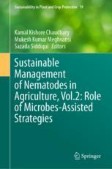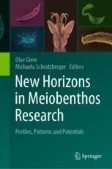Search
Search Results
-
Free-living Marine Nematodes from the East China Sea
This book describes and illustrates 300 species of free-living marine nematodes from the East China Sea and includes eighteen new species....
-
Diversity and abundance of free-living nematodes from Carlini Station, 25 de Mayo/King George Island, Antarctica: a case study in pristine and disturbed soils
The Antarctic continent hosts life forms specially adapted to the extreme climatic challenges. Among these organisms are nematodes, key organisms in...

-
Effects of discarded garbage bags on intertidal free living nematode community
Single-use plastic litter is the main component of marine litter worldwide. In the present study, the impact of discarded single-use garbage bags is...

-
Integrating spatial and temporal patterns of free-living nematodes with physical and chemical environmental traits: implications for coastal ecological monitoring
Relating biological patterns to the physical environment is increasingly explored in current period of global biodiversity crisis and attempts to...

-
Introduction to Marine Nematodes and the East China Sea
Free-living marine nematodes represent the most widely distributed, abundant and diverse metazoan group. In general, they are the most advantage...
-
Biological traits analysis of free-living nematodes as indicators of environmental quality at Lake Bacalar, Mexico
Free-living nematode distribution, abundance, diversity, and biological traits at Lake Bacalar were evaluated to assess the environmental quality of...

-
Morphology of Free-Living Nematode
Free-living marine nematode is a kind of small invertebrate, which lives in marine benthic sediments. It is generally a small, nonsegmented,...
-
Genus-level evolutionary relationships of FAR proteins reflect the diversity of lifestyles of free-living and parasitic nematodes
BackgroundNematodes are a widespread and diverse group comprising free-living and parasitic species, some of which have major detrimental effects on...

-
Distribution patterns of meiofauna and free-living nematodes in beaches of a remote tropical South Atlantic Island (Trindade, Brazil)
Characterizations of meiofauna, as well as of Nematoda assemblages, are rare in oceanic islands due to logistical difficulties and, until now, no...

-
Morphological and genetic diversity of ice-associated nematodes of the family Xyalidae Chitwood, 1951
The ice-associated nematode Theristus melnikovi has a long-distance dispersal throughout the Arctic. However, this species’ taxonomic position and...

-
Biodiversity of macrobenthic nematodes in the intertidal and shallow subtidal zones in the Eastern Canadian Arctic
Free-living marine nematodes play a fundamental role in nutrient cycling and food web dynamics, serving as bioindicators of ecosystem health. Despite...

-
Plant-Parasitic Nematodes and Microbe Interactions: A Biological Control Perspective
Plant parasitic nematodes (PPN) cause significant damage to a broad range of vegetables and crops, worldwide. Biological control agents (BCA)...
-
Arthropods, nematodes, fungi, and bacteria associated with penguin carrion in Barton Peninsula, King George Island, Antarctica
Carrion decomposition contributes to the soil microbial community structure. This research aimed to identify the soil arthropod, nematode, bacterial,...

-
Molecular Systematics of Parasitic Nematodes
The study of molecular systematicsSystematics, where the concept was first introduced in Chap. 1 , enables the...
-
The ability to get everywhere: dispersal modes of free-living, aquatic nematodes
Nematodes colonize almost all aquatic habitats worldwide. Despite their small size, restricted locomotion and lack of pelagic larvae, they can reach...

-
The cryptic microbiota of plant parasitic and entomopathogenic nematodes: diversity, effects on host biology and potential in plant protection
Many plant parasitic and entomopathogenic nematodes harbor specialized and obligate bacteria as well as viruses. Given their evolutionary...

-
Marine Meiofauna Diversity and Biogeography—Paradigms and Challenges
Scientists studying the biodiversityBiodiversity and biogeography of meiofauna encounter many uncertainties regarding the causes and consequences of...
-
The impact of marine vertebrates on polar terrestrial invertebrate communities
Marine birds and pinnipeds which come to land to breed, rest and moult are widely known to fertilize adjacent terrestrial ecosystems, with cascading...

-
Chemical Pollution and Diseases of Marine Mammals
Man-made persistent pollutants (such as PCBs, pesticides and trace metals) reach aquatic organisms through the food chains. Pollutants are ingested...
-
Infectious Diseases of Marine Mammals as Sentinels of Ecosystem Health in the Neotropics
Long-lived aquatic animals, such as marine mammals, can be exposed to several environmental threats. With a wide variety of lifestyles, from large...
